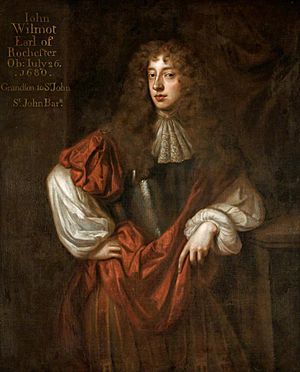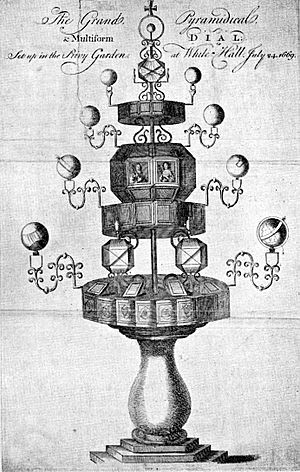Merry Gang facts for kids
The Merry Gang was a group of wealthy young noblemen and friends who were part of the court of Charles II of England during a time known as the Stuart Restoration. Their leader was John Wilmot, 2nd Earl of Rochester. This group was known for their lively and sometimes wild behavior, which often caught the attention of the king. They were also supporters of the arts, helping famous writers like the poet John Dryden and the playwright Nathaniel Lee.
The Merry Gang's influence at court began to fade after the 1670s. This was because new ideas about how gentlemen should behave became more popular, focusing on better manners and less unruly actions.
Contents
Who Were the Merry Gang?
The Merry Gang was known by several different names. The poet Andrew Marvell called them the "Merry Gang." Others called them the "counsellors of pleasure" or the "men of mirth." A historian in 1967 named them the "Court Wits." The leader, Rochester, sometimes called his friends "Rake-Hells," which meant they were a bit wild and rebellious.
Key Members of the Group
Many important people of the time were part of this group. Besides John Wilmot, 2nd Earl of Rochester, other members included:
- George Villiers, 2nd Duke of Buckingham
- Charles Sackville, Lord Buckhurst
- Sir George Etherege
- Sir Charles Sedley, 5th Baronet
- William Wycherley
Many of these members were also leading writers and artists of their time. Lord Buckhurst, for example, was very close to King Charles II. His grandmother had even been the king's governess when he was young, and the king often rewarded his family with titles and land.
What Did the Merry Gang Do?
The Merry Gang believed they had the right to act as they pleased. Their actions were often meant to be entertaining and to get the king's attention and amusement. They were known for being loud and sometimes causing a stir in public.
Incidents and Activities
In 1666, the Duke of Buckingham became involved with Anna Talbot, Countess of Shrewsbury. Two years later, Buckingham fought a duel with the Countess's husband, the Earl of Shrewsbury. The Earl was badly wounded and later died. King Charles II pardoned Buckingham for this event.
In 1675, some members of the gang, including Buckhurst, Rochester, and others, damaged a valuable glass sundial in the Privy Garden of the Palace of Whitehall. This sundial was shaped like a pyramid and was an important feature of the royal gardens.
Another time, in 1676, Rochester and Etherege were involved in a fight in Epsom that resulted in a Captain Downs dying.
The Merry Gang also had connections with Nell Gwyn, who was a long-time friend of the king. Both Sedley and Buckhurst supported her financially at different times, and she also lived with Rochester for a period. Many members of the gang attended her funeral in 1679.
Supporting the Arts
Beyond their lively social lives, the Merry Gang also supported artists and writers. The famous poet John Dryden received their help, and the playwright Nathaniel Lee was also connected to the group. Their activities sometimes appeared in writings that were critical of the king's court.
Over time, the wild behavior of the Merry Gang became less accepted. After the 1670s, new ideas about what it meant to be a gentleman focused more on good manners and polite conduct. This led to the decline of the Merry Gang's influence at court.



